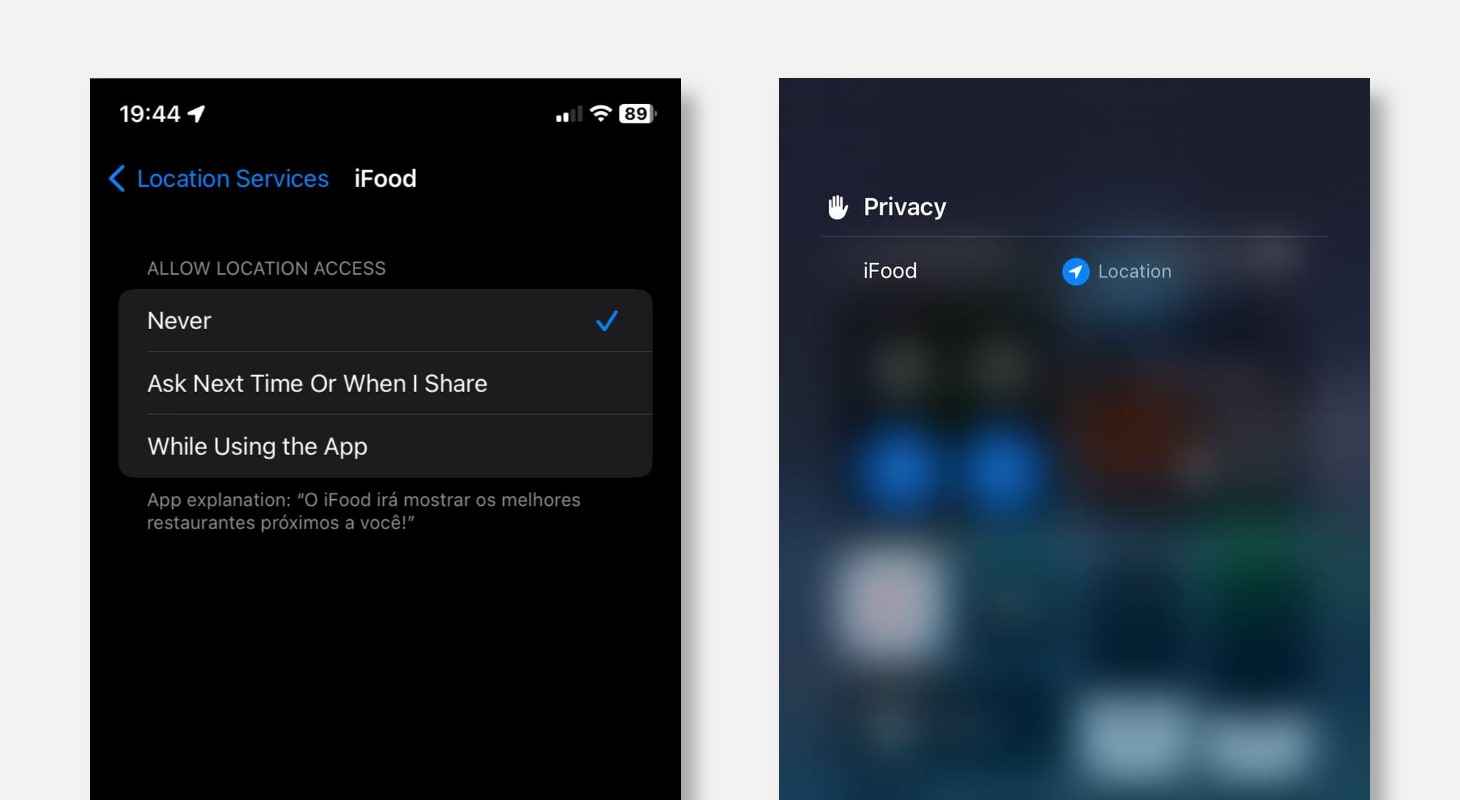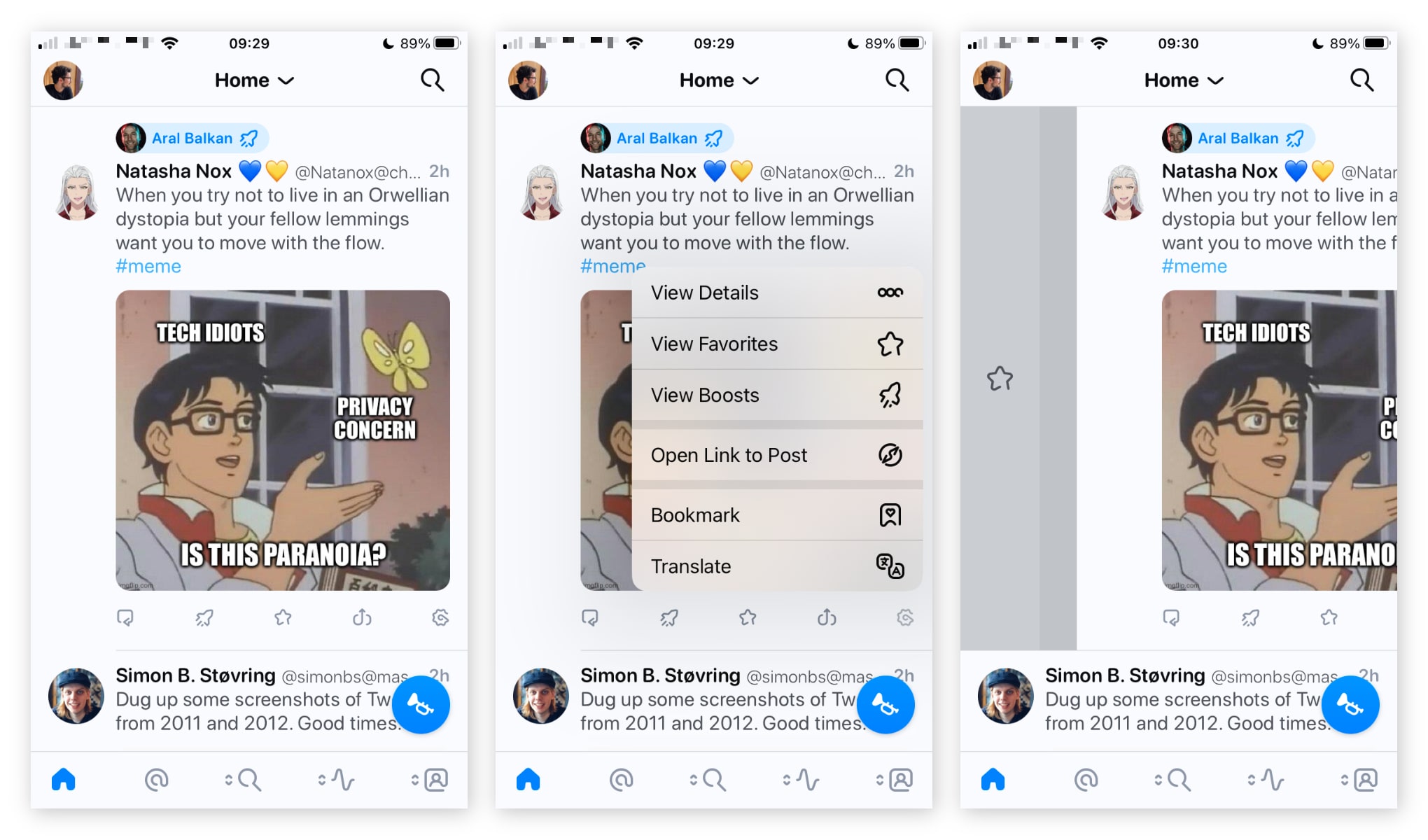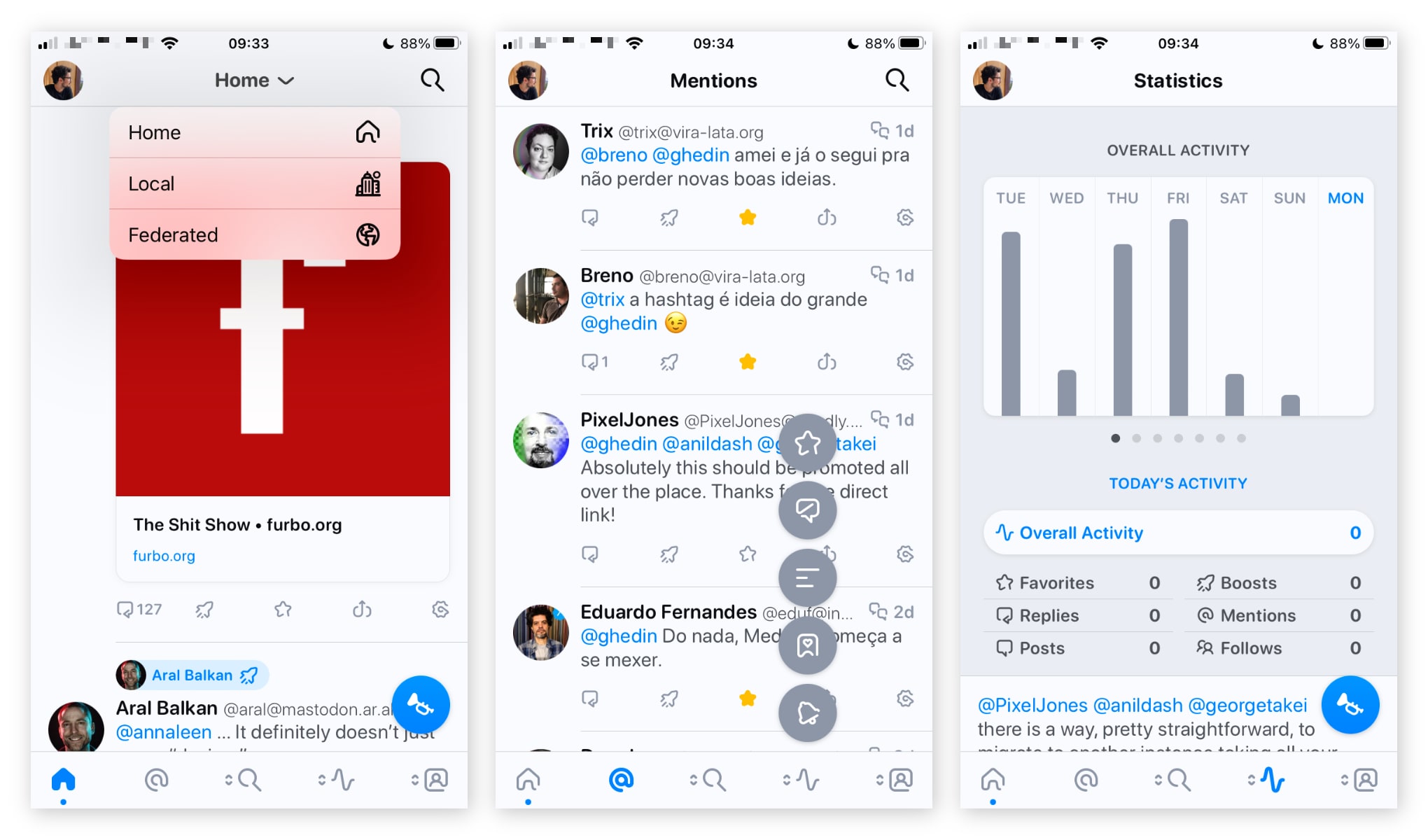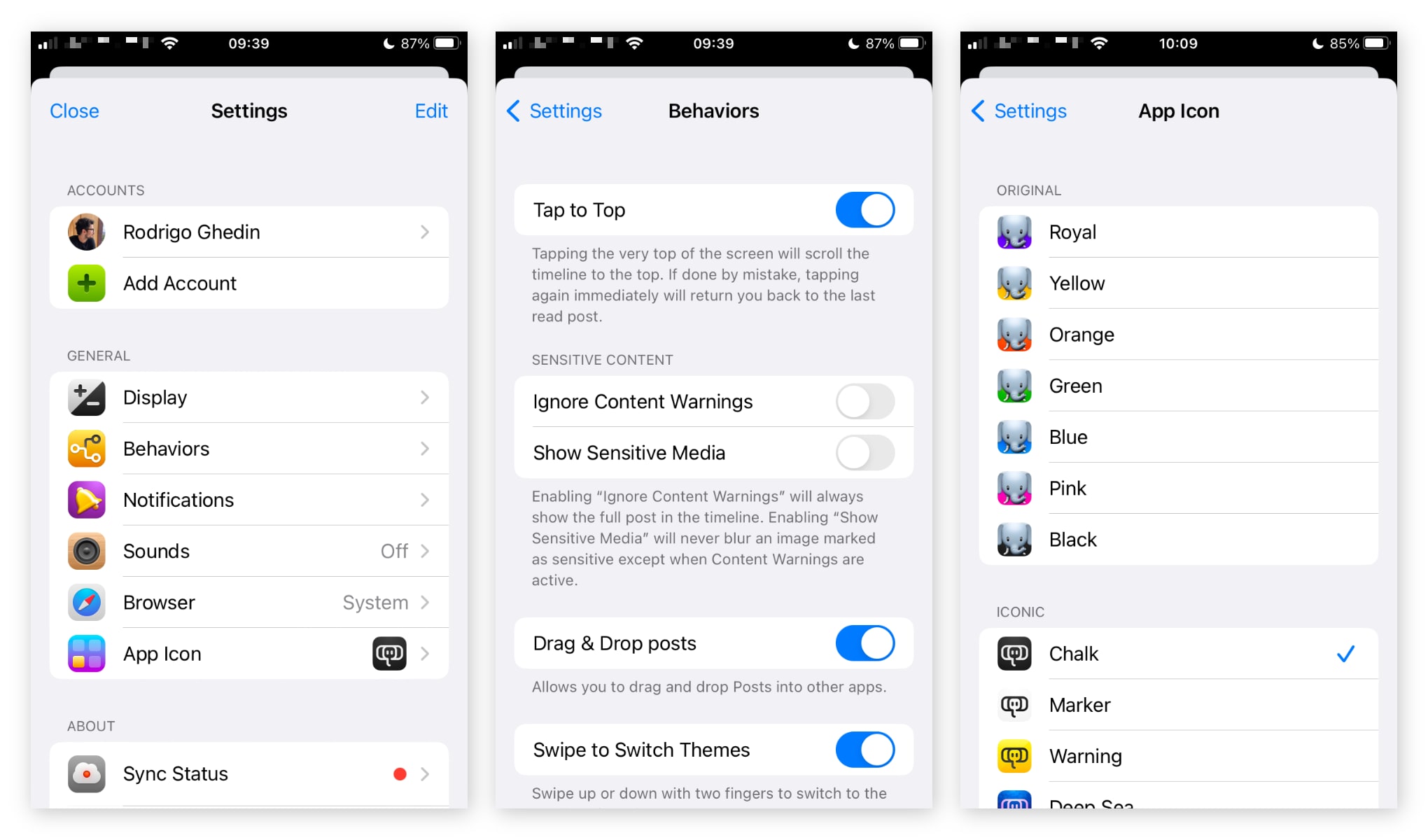31/1/2023
One of the biggest Brazilian apps/startups, iFood, was peeking at iOS users location when it should’ve not.
A reader of Manual do Usuário (my Portuguese-written blog) noticed the glitch/bug while using iOS 16.2.
iFood, Brazilian largest food delivering app evaluated at USD 5.4 billion, was accessing his location when not open/in use, bypassing an iOS setting that restrict an app’s access to certain phone’s features. Even when the reader completely denied location access to it, iFood’s app continued to access his phone’s location.

We got intrigued: how was iFood getting away with this?
An educated guess was revealed by iOS 16.3 release notes, launched on January 23th. Apple mentions a security issue in Maps in that “an app may be able to bypass Privacy preferences”. It’s CVE-2023-23503, submitted by an anonymous researcher and, so far, “reserved” in CVE’s system — which means details are pending to be published.
The reader who noticed iFood’s misbehavior said that afterwards, he reseted his iPhone and that apparently solved the issue. He promptly updated to iOS 16.3 as soon it was released. So far, he haven’t notice anything unusual.
I contacted iFood’s press team to get a word about this issue. They received my request, asked for more details, but haven’t provided a statement so far. When they reply, I’ll update this post.
Update (February 1st, 17h35): iFood just sent a statement. Here it goes (my translation):
iFood reinforces that data security is a priority in its business and in the relationship with consumers, deliverers, and restaurants. The data collected is used only for the purposes set out in our Privacy Statement.
In this case, after careful analysis by the technology team, no code was identified in the iFood application that allows access to the user’s location without authorization, but even so, the company remains available to clarify any questions on the subject or any alleged failure, in order to contribute to bringing more security to the platform.
Present in over 1,700 cities in Brazil and a reference in online delivery, iFood constantly invests in security, technology and monitoring to identify and correct possible flaws and continuous improvement of the application.
23/1/2023
A few centuries later, I feel today what British craftsmen and small producers must have felt when they saw the first machines arrive and the first factories open during the Industrial Revolution.
A new technology, generative artificial intelligences (AI), poses a threat to intellectual jobs that until recently — about five years ago — seemed safe in the face of overwhelming labor automation.
Not anymore. AIs such as ChatGPT, the LLM (large language model) type, are capable of generating coherent original texts from short prompts written by humans.
Like all revolutionary technology, it seems like magic. And it is no coincidence that I return to the same topic in less than two months. ChatGPT was launched five days after I published that first column.
Instead of spending a few hours on research, writing and editing to publish this text, for example, I could have asked ChatGPT to write something about the threat of AIs to those in the writing business. Very meta — and tired; I will spare you that.
The result would not be the same, but it would probably be “good enough”. We know, not from today, that “good enough” is often… good enough for a lot of people. And being cheaper and faster to produce, it is hard to resist.
Today, generative AIs are still a kind of curiosity, a topic for dazzled texts on LinkedIn, creative tests, experimental solutions. The potential, however, is there, wide open.
Microsoft, one of the main backers of OpenAI, the company behind the most advanced AIs (besides ChatGPT, it also owns DALL-E 2, GPT-3, and Codex), announced last week that it’s offering OpenAI services in its cloud solution and already offers features based on them in some commercial products, such as Github Copilot and Microsoft Designer. Rumors suggest that ChatGPT will soon arrive in Bing and productivity applications (Word, Excel, PowerPoint, etc.).
In journalism and writing for the web, the potential is explosive.
For years, some newsrooms, such as the Associated Press, have been using robots to produce simple texts, such as news on company balance sheets and sports results.
With the new generative AIs, this practice changes levels. Until now, the texts written by robots were sort of a logical, understandable “script”: take this data and put it into a template. With ChatGPT, however, the robot seems to gain imagination and the logic gets lost in complex and opaque algorithms.
The result is also of a different magnitude. ChatGPT creates arguments, detects consensus, discovers controversies. Although lacking awareness, it simulates one. It is “good enough.”
CNet, a US publication covering technology, began testing such an AI last year in the worst possible way: with little transparency.
Someone found out, and under scrutiny, basic errors were discovered in the nearly 80 published robotic texts. A widespread failure: of the AI and of the human being (supposedly) responsible for checking and editing the artificial text.
These are mistakes that perhaps the next version of GPT will not make. The pace is breakneck.
In the journalism domain generative AIs may not be ready for production, but in other less demanding ones they already do very well, thank you: quick responses to emails, answers to search engine queries, social network posts, top-of-funnel content for institutional blogs.
You don’t have to do much research to come across dozens of startups trying to get ahead in this new gold rush — trying to sell shovels to the prospectors who, in the end, will be using them to dig the graves of their own jobs and those of others.
When these AIs are good enough, job openings are reduced and the assignments of those left over change. From writers and editors, for example, we all become “robot babysitters”, correcting blatant (for humans) errors that may slip by in the artificial text and that we, of course, manage to catch. (Because if there is one thing we are good at, it is failing; even in this the AI reproduces us.)
Soon, my routine will gain one more demand: to prove myself flesh and blood in a purely digital environment, full of “rivals” who do not sweat, get tired, get sick, and have no mood swings. We are playing in the opponent’s camp. It is an inglorious struggle.
Unlike the 18th century British Luddites, I don’t even have a machine to wreck. The generative AIs that threaten my craft exist in the cloud, that ethereal concept, mere euphemism for “big computers in controlled warehouses far away from us”. No gunfights against robots that look like Arnold Schwarzenegger, forget about it. The machine revolution will be discreet.
And unlike what the best utopias predicted, we won’t even be able to dedicate ourselves to the arts, because generative AIs also already produce illustrations, paintings and photos. They even win contests.
Perhaps our fate, the fate of humanity, is that we will all become Simpsons grandpas screaming against the cloud. What a pathetic end.
16/1/2023
From the same developers of Tweetbot, here comes Ivory: a marvelous Mastodon app for iOS.
Ivory is still in alpha, i.e., in testing and (supposedly) with some rough edges. Last Saturday (14), I got access to this test version, which I now present here.
The good news is that Ivory is very reminiscent of Tweetbot and, at the same time, assimilates well the peculiarities of Mastodon. It couldn’t be different: its base is the same as Tweetbot’s and Tapbots’ craftmanship in making great apps is well known.
When you open the app, you see the main timeline. Under the posts you see the typical action buttons — reply, retweet (here called “boost”), and favorite —, plus two “internal” buttons — the share sheet and a configuration button that brings things like bookmarks, translation, and post and profile details.
Gestures, inherited from Tweetbot, are present:
- Drag to the left to open the post in detail — see replies and meta data from it;
- Drag to the right to access quick shortcuts — favorite and reply by default; you can change these commands in the application settings.

Screenshots: Ivory/Rodrigo Ghedin.
One cool detail about Ivory is that it features Mastodon’s timelines — something that, weirdly, the official app has chosen to leave out. Unlike Twitter, where there is only one, Mastodon offers three:
- Home, the default, contains the posts of the people you follow in any instances;
- Local, which displays all the posts from everyone who is in the same instance as you; and
- Federated, which displays all posts from all profiles connected to your instance, i.e. everyone that at least one person from your instance follows.
At the bottom of the window is a main menu with five icons, two of them fixed (timeline and replies) and three customizable. To change one of these three, just hold your finger on it.
The areas available there are quite varied. The highlights are the bookmarks (a kind of “private favorite”, to save posts without notifying/alerting their authors) and the statistics, which brings a series of data about your behavior while using Mastodon.

Screenshots: Ivory/Rodrigo Ghedin.
The post button is floating. You can drag it to any of the four corners of the screen.
When you tap it, it displays the composing screen. Again, all the basic options are there, even the four levels of visibility that Mastodon offers.
Not everything is perfect and up to date so far. Ivory does not yet include editing posts, a feature that has existed in Mastodon since March 2022, nor the creation of posts with content warning.

Screenshots: Ivory/Rodrigo Ghedin.
Other features are absent, such as support for instance-specific emojis. All of these are on the developers’ radar. On Ivory’s website there is a list of these pending issues (“Current Roadmap”) which they promise will be fixed in the near future.
In the settings, you can add other accounts, change the behavior of the application and how it handles Mastodon features (for example, open all content warnings by default) and even customize details of the experience, such as the sounds (very tasteful, but I choose to disable them) and the app icon.

Screenshots: Ivory/Rodrigo Ghedin.
Ivory is still in the “alpha” stage, but it doesn’t look like it: in two days of use, I didn’t run into any errors and the app worked very well.
No word yet on when Ivory will be released. The recent breaking of Twitter’s API for third-party apps, including Tweetbot, should speed up the release of Ivory.
On Mastodon, Paul Haddad, one of the Tapbots developers, announced that Ivory’s development has gone into “hyper mode” in order to resolve the 3-4 mandatory fixes before submission to the App Store. On Saturday (14), Ivory’s profile reported that an early access version is expected to be released by the end of January.
Ivory will be paid, probably by subscription — just like Tweetbot. If the same pricing as for the Twitter app is used, we are talking about USD 0.99 per month or USD 5.99 per year.
A macOS version of Ivory is also being developed. It is not yet available or in testing and there is no release date planned.
17/12/2022
Young, billionaire, CEO and owner of majority voting power of a global company that owns apps and social networks used by billions of people every day. I am talking, of course, about Mark Zuckerberg.
Those who read this resume and know Zuck’s story might imagine a modern, digital version of the great inventors of the past. A creative, innovative brain, a living legend among us. The Einstein of this generation, the Nicolaus Copernicus of the 21st century who saw before everyone else that our lives would revolve around connected screens.
Except that this is not the case. Sorry to say, but Zuck is a good businessman and an excellent copycat. And that is all. He is no visionary.
For some years now, Zuckerberg’s empire has been under real threat for the first time. It’s a modern version of the Opium Wars that set Britain empire on a collision course with a closed and powerful China in the 19th century. Only now the opium is different: it is the endorphin shot released by likes and 15-second viral videos.
When he saw himself losing the Gen Z to TikTok, Zuckerberg reacted as usual: by copying. He copied TikTok right out of the box. What are the Reels if not a poor copy of TikTok, “please don’t upload videos from TikTok to Reels”?
Like any good warlord, Zuckerberg acts on several simultaneous fronts and tries to anticipate the next moves of his 5D chess game. While he tries to contain the advance of the Tiktokian troops on the current battlefield, he spends billions of dollars on his nucelar weapon: the metaverse.
It would be fascinating if it were new, but the metaverse is just the latest in a series of attempts to make virtual reality a thing, a technology that sounds interesting on paper but has been making human beings puke and/or get a headache since the 1980s.
Even the name is not original. Zuck stole the word “metaverse” — to the point of changing the name of his company to Meta — from a Neil Stephenson novel that he must have read as a teenager and thought was awesome.
(Indeed, a black and oriental samurai who is also a super hacker, a description of Hiro Protagonist, the protagonist of Stephenson’s Snowcrash, is an irresistible character.)
Two of Meta’s three main apps were bought — that’s where Zuckerberg’s business abilities comes in. Instagram and WhatsApp were the biggest bargains in tech business history. They would have been threats to Facebook itself had they not been acquired while there was still time.
When he tried the same thing with Snapchat, another threat that emerged in 2013, Zuck was met with something new: a “no”.
The refusal led him to desperate measures, and it was then that he discovered the power of copy, although not at first.
Before he ended Snapchat’s growth by copying the stories feature on Instagram, Zuck tried his luck with dedicated, uninspired, and forgettable apps like Poke, Slingshot, and Bolt. (If you don’t remember those, don’t blame yourself.)
Incidentally, it’s curious how Zuckerberg’s history of failed copies seems to be largely ignored.
Besides the failed copies of Snapchat, in a quick, off the top of my head list, I recall that he has already tried unsuccessfully to copy:
- Twitter in 2013, adding “follow” and sharing (RT) features to Facebook.
- IGTV in 2018, an ambitious undertake against YouTube that came to nothing.
- Tinder, in another feature stuck on Facebook that… seriously, does anyone use this thing?
Facebook, by the way, was a copy made in earlier stages. In 2003, the Winklevoss brothers approached a bright young programmer in their dorm room at Harvard University to help them with a project to create a social network for college students. The young man was Zuck.
He liked the idea, but not the partners, so he decided to bypass the Winklevoss and go for it by himself. Typical Zuckerberg.
But those who think that Facebook was Mark’s original sin are wrong.
Before this, he had caused controversy at Harvard by launching FaceMash, a site that took pictures of students from the university’s central directory and put them side by side for others to choose the hottest people.
It was a copy of Hot or Not, launched three years earlier by two Silicon Valley engineers who had made a habit of rating the beauty of random women on the street, as they were walking pieces of meat, and did not always agree with the “grades” they assigned to them.
In this incident, Zuck almost committed the single creative act of his entire career. The original idea of FaceMash was to compare the students’ photos with those of animals.
In his blog, he wrote at the time:
9:48pm. I’m a little intoxicated, not gonna lie. So what if it’s not even 10pm and it’s a Tuesday night? What? The Kirkland facebook is open on my computer desktop and some of these people have pretty horrendous facebook pics. I almost want to put some of these faces next to pictures of farm animals and have people vote on which is more attractive.
Ops, maybe… not even this? He proceeded:
It’s not such a great idea and probably not even funny, but Billy comes up with the idea of comparing two people from the facebook, and only sometimes putting a farm animal in there. Good call Mr. Olson! I think he’s onto something.
A little over two hours later, Zuck announced on the same blog that he was working on the project, but had left out the animals.
Discuss @ Hacker News.
13/12/2022
It was predictable that Elon Musk’s Twitter would become an unhealthy environment, but it was surprising how quickly it deteriorated. This, added to the despicable, sometimes criminal ideas of its new owner, leads us to the only possible outcome: it is time to jump ship, to leave Twitter.
The reasons are many, all documented in Twitter is Going Great, a real-time coverage, timeline format, of the permanent catastrophe that Twitter has become.
Last weekend, Musk managed the feat of offending, with just one post, the United States’ top health authority in the fight against COVID-19 and all trans people.
In another instance, he made unfounded accusations that Yoel Roth, an executive who headed Twitter’s safety department, had advocated pedophilia in his phD thesis. (This is not the first time Musk has accused opponents of being pedophiles without any shred of evidence.) It was a lie, a retaliation. Days earlier, Roth had resigned and publicly criticized Musk.
You can tell from this and other news that Twitter is controlled by an extremist with an inflated ego, someone dangerous and ill-intentioned, and who happens to be the richest person on Earth. There is no way that this can work.
Not that I believe that all the services and products I use are controlled by people who are well-meaning or at least in line with my beliefs. It is just that, in the case of Twitter, the rottenness became explicit; the rancid smell, unbearable.
Some say that it is valid to swallow your pride and stay in hostile environments in order to “occupy the space” and not give it up to the “other side”. This is nuts. In the fight between progressives and conservatives — in any dispute that takes place on Twitter, in fact —, there is only one possible winner: Twitter itself, now inseparable from Elon Musk, its sole owner.
To be there is in itself a defeat for us, a victory for Musk and his erratic agenda. I don’t want to be a part of that.
A week ago I wrote a farewell to Twitter. I was in doubt. Then I read that the Platformer newsletter, the outlet that has given the most scoops in covering Musk’s Twitter era, has decided to leave Twitter. It was the push I needed.
In January 2008, when I signed up for Twitter, my first post there was something along the lines of “If you can’t stand them, join them…”. Not anymore.
Discuss @ Hacker News.
30/11/2022
There is a revolution happening on the Internet and you haven’t noticed it. That’s okay, that’s the point. Artificial intelligences (AIs) capable of producing readable and coherent text, incredible images, and even videos are among us and already create much of the content that appears in our wanderings around the web and on social media.
We are living the machine revolution — of content.
Systems like OpenAI’s GPT-3 create long form text from commands or short sentences. A few days ago, Meta launched a version fluent in academic writing, Galactica, to the horror of experts, worried about the instrumentalization of this new tool to give a tone of legitimacy to half-baked theories.
In recent years, startups have been founded on the promise of convincing texts with the push of a button. They are already used in the day-to-day operations of many other companies, as Christopher Mims revealed in his column in the Wall Street Journal.
“It is probably impossible that the majority of people who use the web on a day-to-day basis haven’t at some point run into AI-generated content,” said Adam Chronister, owner of a search engine optimization (SEO) studio.
These startups — SEO.ai, TextCortex AI, Neuroflash, among others — address a “pain” of small and medium-sized companies that, with tight marketing budgets, have until now resorted to human copywriters to produce superficial articles as part of their customer acquisition strategies.
These are articles created from searches to other articles available on the web, repackaged with SEO techniques, whose goal is to be well positioned in searches on Google and other search engines to, in the end, sell a product or service. Preferably for as little money as possible. In short, the content production industry.
Researcher Kate Eichhorn, from MIT, is fascinated by content as an object of research. So much so that she wrote a book, entitled Content, to rescue the origins, classify and, in the end, try to define this term, which is so elastic and that, in recent years, has become part of our daily lives, even becoming a profession, the infamous “content creator”.
Her vision of content is not the most encouraging:
The rise of the content industry is the ultimate expression of neoliberalism. Under the logic of neoliberalism, everything—politics, desire, sociality, art, culture, and so on—is reduced to mere nodes in the market economy. Reducing all forms of cultural production to content not only conveniently erases the specificity of different types of cultural production but also effectively ensures that all types of cultural production can be easily substituted for each other and exchanged. After all, all content is part of a single and indistinguishable flow.
It’s a very interesting little book, this one by Kate. In the conclusion, when addressing automation, Kate acknowledges that “content and the content industry are here to stay; in fact, much of the damage has already been inflicted”.
The author talks about “resistance” as a remedy to the flood of empty content, about valuing what is made by people like us, with any intention other than to sell and/or circulate (which is the same in content logic). Nothing that will curb or stop industrial scale production, but a healthy resistance, still possible.
In a more optimistic vein, Arvind Narayanan, professor of computer science at Princeton University, draws a parallel between writer AIs and the calculator in the classroom environment.
As computer-generated text become compelling, inexpensive, and pervasive, our relationship with this medium changes. How can this shift be exploited to the benefit of us, the flesh and blood people?
Students have already figured out that AIs write well and have started using them to do school lessons, especially the boring and meaningless “write five paragraphs on the benefits of biotechnology” (his example), which teach nothing about writing, critical thinking, nor biotechnology.
Since the texts generated are somehow unique, it is not as easy a cheat to detect as the infamous Wikipedia copy and paste. Even if all students in a class use the same AI, each will have a different, unique text to present to the teacher.
For Arvind, the change that is needed is similar to the introduction of the calculator — at first despised in the classroom, then incorporated, and now indispensable. Resistance is useless, we will have to adapt. This may even prove to be a positive thing:
In some cases, the point of assigning an essay is to teach writing skills or critical thinking. The availability of language models has not obviated these skills. […] [T]here are many ways to change the exercise so that the tools aren’t helpful. These changes take advantage of inherent limitations of language models that are unlikely to be fixed soon.
Let’s make no mistake, though. In the day-to-day pressure, content-generating AIs will be used willy-nilly to produce whatever they can. Laziness, that all-too-human feeling, almost always wins out, and industry incentives will be increasingly tempting.
In recent weeks, general-purpose applications have launched their AI systems, such as Canva and Notion. Google already helps the user write emails, LinkedIn suggests pre-defined and contextual messages in conversations and comments.
Kate explicitly says that resisting is not a “neo-luddist” act, but… maybe it is? It is easy to envision a near future in which people who write their texts by themselves, without the aid of an artificial intelligence, will be seen as eccentrics, craftsmen of the word.
There will be less space, it’s true, because you can’t compete with machines in volume, and that’s what content is all about. Back to Kate:
So, what is the content industry? In essence, it is an industry that generates revenue from the production and/or circulation of content alone. The content in question sometimes conveys information, tells a story, or entertains, but it doesn’t need to do any of these things to circulate effectively as content (again, consider the Instagram Egg).
When thinking about content, I always remember this funny column (in Portuguese) by Ricardo Araújo Pereira in which he gives a scathing critique of the internet — the kind of thing a machine probably couldn’t do; or maybe it could, after devouring Ricardo’s columns:
For example, whenever someone who writes, sings, or acts says they produce content for the Internet, I get a little bit of a chill.
Never in the entire history of the world has a winemaker said that he produces content for bottles, because the winemaker respects wine too much to say such a thing. Not least because he is not particularly dazzled by the existence of bottles. Yes, bottles are useful, but it’s the wine that matters.
However, there are artists who have such admiration for the Internet that they are satisfied to say that they produce content for it.
We continue steadily in the production of wine, I mean, words.
Discuss @ Hacker News.




